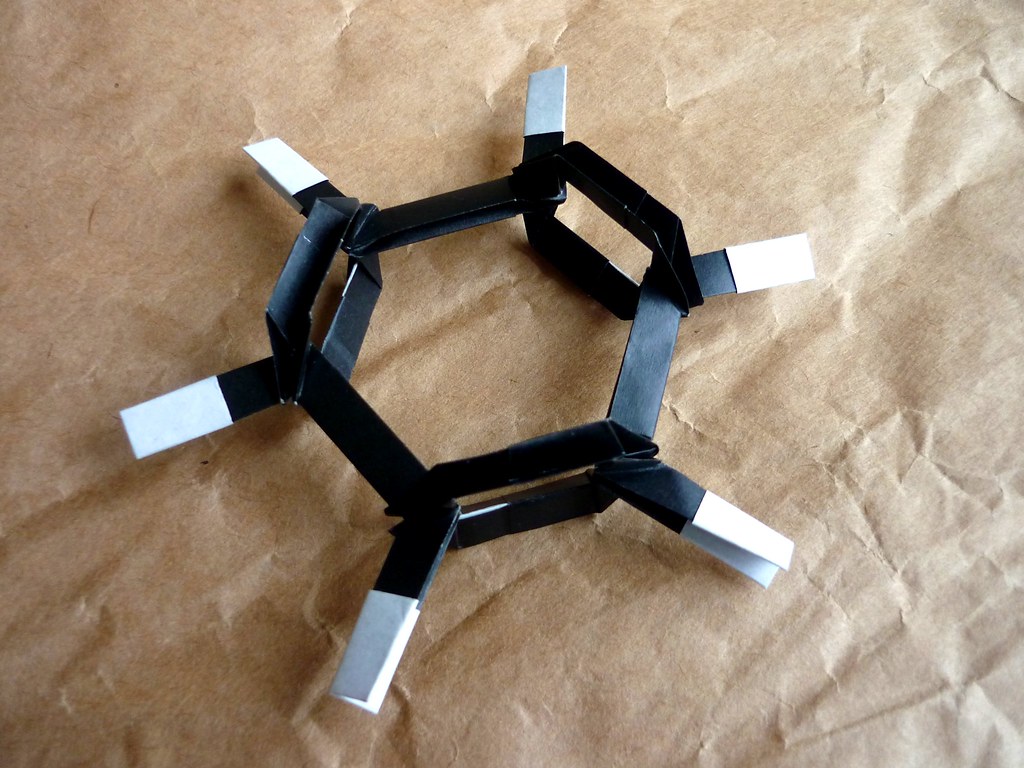I've been interested in chemistry for seemingly forever, and I've made a couple models in the past to try to represent concepts in chemistry. However, for the longest time what I really wanted to fold was an organic chemistry model kit. I'd seen one before somewhere (if you find it, feel free to send me the link) but I thought it would be best if I designed my own.
My main problem when trying to fold a model kit was the tetrahedral shape. I could see how it would be possible to fold a unit from a single square, but not without wasting a lot of paper. Finally, for some reason I had the idea to fold two identical units that could fit together to make the tetrahedron. I tried folding the elbow section so that the slits on the two units would fit together, but that didn't have any way of locking. After playing with that idea, I decided to try something else: using two different units. At first, one unit was just a 90° elbow using reverse folds, and the other flat piece was simply slid into the elbow. That, like before, fell apart easily; however, by changing the elbow to have alternating 22.5° angles, the second unit locked in place nicely. I left the model like that until a couple days ago, when I realized that one of the units was too floppy. I added a sink fold to unit 1 and a crimp to unit 2 so that both units would hold their respective angles equally. The result is a couple of really simple units which can make just about any molecule, such as ethanol:

Or benzene:

The diagrams show how to make and assemble the two tetrahedral units, as well as the hydrogen unit. The tetrahedral angles should be 109.5°, but the diagrams use 90°. This is on purpose because the angles tend to unbend a little. Note that a lot more can be improvised such as double bonds and simply atoms like oxygen and sulfur. I haven't quite figured out how triple bonds or sp
3 centres with a lone pair (such as nitrogen) will work, but I'm pretty sure they're both possible.
Click Here for Diagrams.
Normally I wouldn't draw diagrams, especially not for something so simple. For some reason I hope that the model might be useful for someone who, like me, never had a model kit. Unfortunately with things like closed sinks and crimps involved a non-folder might have a bit of trouble, although I would love to be proved wrong.




4 comments:
http://danoftoasters.org/?sample=no&page=3
This is probably what you're thinking of. Shuzo Fujimoto has also done a very nice one, info is in one of his books-- I can dig it up for you if you want.
Yours is so elegant though... Might actually be worth the effort as a study tool :)
I'm pretty sure thats the one I'd seen before. I'd be curious to see what the units are like in Fujimoto's version, but even a description would suit me.
And thanks, thats the idea. Unfortunately I feel like I can't simplify it enough so that anyone could use it. I hope someone will benefit from it, though.
Hi Ryan,
I am interested in using your origami model kit for a piece of cover art to accompany an article in the Journal of Organic Chemistry.
Please get in touch if such a project would be of interest to you.
Regards,
Dan
danbchem[at]gmail.com
hi Ryan
your tetrahedra model is the one i am searching for the last month. I have some doubts. can you pls give me your mail id? so that i can ask clearly the doubts.
anoopthomas.01@gmail.com
Post a Comment